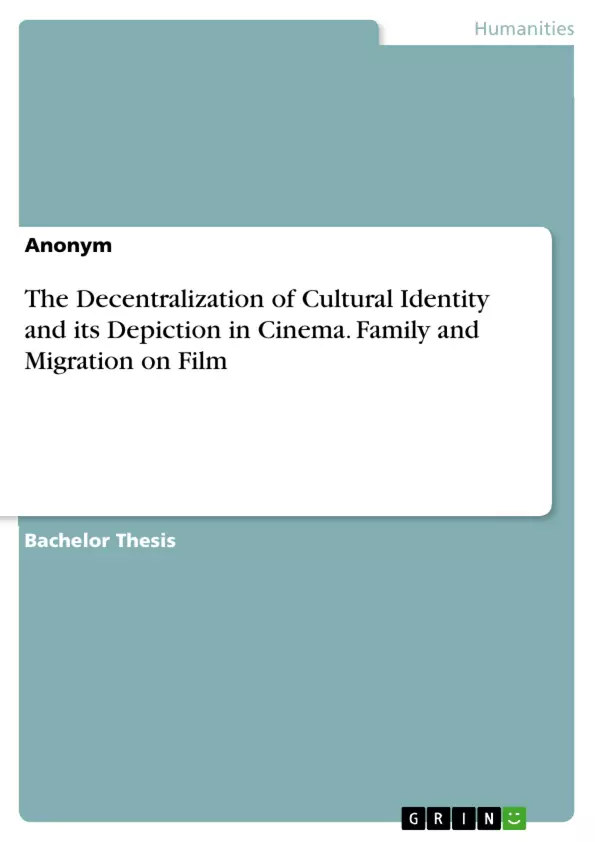This thesis aims to investigate how the medium of film thematizes the issue of the decentralization of cultural identity based on Indian immigrant families in the film The Namesake by Mira Nair.
The intent behind this paper’s focus on family is to include not only first-generation immigrants that undergo a change regarding their identity but also the likewise affected second-generation immigrants within these families. On that note, it is evident that, in order to answer the question of how film approaches the issue of the decentralization of cultural identity, an adequate case example is required to represent that subject matter sufficiently. The selected film The Namesake by Mira Nair possesses the vital attribute of showcasing a persuasive display of clashing cultural identities and puts emphasis on the topic of migration.
Inhaltsverzeichnis (Table of Contents)
- Introduction
- Methodology
- Theoretical Background
- Concepts of Identity
- Impact of Globalization
- Late-modernity and the Modern Subject
- Idea of National Identity
- Hybrid Identities and Translation
- Analysis
- Ashima's Translation
- Duality between Gogol and Nikhil
- Gogol's American Belonging and Strive for Cultural Purity
- Clashing Cultures - Family Conflicts and Tensions
- Clinging to Tradition - Gogol's Change of Heart
- Embracing Hybridity
- Conclusion
Zielsetzung und Themenschwerpunkte (Objectives and Key Themes)
This paper aims to investigate the depiction of the decentralization of cultural identity in cinema, focusing on the experiences of Indian immigrant families in the film The Namesake by Mira Nair. It explores how the medium of film thematizes the complexities of identity and belonging in a globalized world.
- The impact of globalization on cultural identities and the rise of hybrid identities.
- The challenges faced by first-generation immigrants in adapting to a new culture.
- The complexities of navigating dual cultural identities, particularly for second-generation immigrants.
- The role of family dynamics and cultural conflicts in shaping individual identities.
- The film's use of cinematic techniques to convey themes of identity and cultural displacement.
Zusammenfassung der Kapitel (Chapter Summaries)
- Introduction: This chapter introduces the concept of identity in a globalized world, highlighting the significance of identity formation and its potential disruption. It establishes the connection between film and culture and introduces the film The Namesake as a case study for exploring the decentralization of cultural identity within immigrant families.
- Methodology: This chapter outlines the research methodology, explaining the theoretical framework employed in the analysis. It discusses the concepts of identity and their evolution, the influence of globalization, and the concept of the late-modern subject.
- Theoretical Background: This chapter delves deeper into the theoretical concepts that underpin the analysis of cultural identity. It explores different conceptions of identity, including the Enlightenment subject, the sociological subject, and the post-modern subject. It also addresses the importance of national identity and the concept of hybrid identities.
- Analysis: This chapter analyzes the film The Namesake, focusing on key characters and their experiences with cultural identity. It examines the character of Ashima and her struggles as an Indian immigrant, the duality of Gogol's identity, and the conflicts and tensions that arise within the family due to different cultural values.
Schlüsselwörter (Keywords)
This paper explores key concepts related to cultural identity, migration, and the representation of immigrant experiences in film. It focuses on themes such as cultural hybridity, assimilation, family dynamics, and the impact of globalization on individual identities. The film The Namesake serves as a rich case study for examining these concepts, highlighting the complexities of navigating multiple cultural identities within a globalized context.
- Quote paper
- Anonym (Author), 2021, The Decentralization of Cultural Identity and its Depiction in Cinema. Family and Migration on Film, Munich, GRIN Verlag, https://www.grin.com/document/1144627



